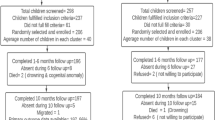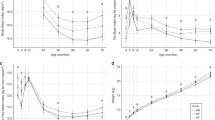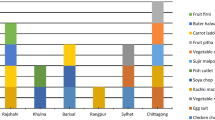Abstract
Background
With the introduction of complementary food, long-chain PUFA (LC-PUFA) supply usually decreases during the second 6 months of life. However, the need for LC-PUFA is still high for infant’s rapid development. The aim of this randomized, controlled intervention trial was to examine the effects of an increased n-3 (LC-)PUFA supply using alternative complementary foods on infants’ visual and cognitive development.
Methods
Mother–child dyads of term infants were recruited in maternity hospitals and randomly assigned to one of three study groups, which all were fed according to the German dietary schedule for infant nutrition. Intervention group IG-R (n = 54) received jars of complementary food with rapeseed oil, IG-F (n = 48) jars with oily fish twice a week and the control group (CG, n = 58) the same jars as IG-R with corn oil instead of rapeseed oil during the intervention period (5th–10th month of age). The outcome measures were latencies of FVEP, Bayley’s mental developmental index (MDI), and psychomotor developmental index (PDI).
Results
At 10 months of age, there were no significant differences in latencies of FVEP, Bayley’s MDI, or in PDI index between the intervention and control groups.
Conclusions
Fish and rapeseed oil used as (LC-)PUFA sources provided with complementary feeding embedded in a structured infant diet did not affect visual or cognitive development of term infants.
This is a preview of subscription content, access via your institution
Access options
Subscribe to this journal
Receive 12 print issues and online access
$259.00 per year
only $21.58 per issue
Buy this article
- Purchase on Springer Link
- Instant access to full article PDF
Prices may be subject to local taxes which are calculated during checkout


Similar content being viewed by others
References
Agostoni C. Role of long-chain polyunsaturated fatty acids in the first year of life. J Pediatr Gastroenterol Nutr. 2008;47:41–44.
Koletzko B, Boey CCM, Campoy C, Carlson SE, Chang N, Guillermo-Tuazon MA, et al. Current information and Asian perspectives on long-chain polyunsaturated fatty acids in pregnancy, lactation, and infancy: systematic review and practice recommendations from an early nutrition academy workshop. Ann Nutr Metab. 2014;65:49–80.
Koletzko B, Lien E, Agostoni C, Bohles H, Campoy C, Cetin I, et al. The roles of long-chain polyunsaturated fatty acids in pregnancy, lactation and infancy: review of current knowledge and consensus recommendations. J Perinat Med. 2008;36:5–14.
Martinez M. Tissue levels of polyunsaturated fatty acids during early human development. J Pediatr. 1992;120(4 Pt 2):129–38.
Lauritzen L, Hansen HS, Jorgensen MH, Michaelsen KF. The essentiality of long chain n-3 fatty acids in relation to development and function of the brain and retina. Prog Lipid Res. 2001;40:1–94.
Simmer K, Patole SK, Rao SC. Cochrane Database Syst Rev. 2011;7:CD000376 https://doi.org/10.1002/14651858.CD000376.pub3.Review.
Qawasmi A, Landeros-Weisenberger A, Bloch MH. Meta-analysis of LCPUFA supplementation of infant formula and visual acuity. Pediatrics. 2013;131:e262–72.
Qawasmi A, Landeros-Weisenberger A, Leckman JF, Bloch MH. Meta-analysis of long-chain polyunsaturated fatty acid supplementation of formula and infant cognition. Pediatrics. 2012;129:1141–9.
Kuratko CN, Barrett EC, Nelson EB, Salem NJR. The relationship of docosahexaenoic acid (DHA) with learning and behavior in healthy children: a review. Nutrients. 2013;5:2777–810.
Gould JF, Smithers LG, Makrides M. The effect of maternal omega-3 (n-3) LCPUFA supplementation during pregnancy on early childhood cognitive and visual development: a systematic review and meta-analysis of randomized controlled trials. Am J Clin Nutr. 2013;97:531–44.
EFSA Panel on Dietetic Products, Nutrition and Allergies (EFSA NDA Panel). Scientific Opinion on health benefits of seafood (fish and shellfish) consumption in relation to health risks associated with exposure to methylmercury. EFSA J. 2014;12:80.
Campoy C, Escolano-Margarit MV, Anjos T, Szajewska H, Uauy R. Omega 3 fatty acids on child growth, visual acuity and neurodevelopment. Br J Nutr. 2012;107(Suppl 2):85–106.
Beyerlein A, Hadders-Algra M, Kennedy K, Fewtrell M, Singhal A, Rosenfeld E, et al. Infant formula supplementation with long-chain polyunsaturated fatty acids has no effect on Bayley developmental scores at 18 months of age–IPD meta-analysis of 4 large clinical trials. J Pediatr Gastroenterol Nutr. 2010;50:79–84.
Martinez M, Ballabriga A, Gil-Gibernau JJ. Lipids of the developing human retina: I. Total fatty acids, plasmalogens, and fatty acid composition of ethanolamine and choline phosphoglycerides. J Neurosci Res. 1988;20:484–90.
Schwartz J, Drossard C, Dube K, Kannenberg F, Kunz C, Kalhoff H, et al. Dietary intake and plasma concentrations of PUFA and LC-PUFA in breastfed and formula fed infants under real-life conditions. Eur J Nutr. 2010;49:189–95.
Jackson KA, Gibson RA. Weaning foods cannot replace breast milk as sources of long-chain polyunsaturated fatty acids. Am J Clin Nutr. 1989;50:980–2.
Hoffman DR, Theuer RC, Castaneda YS, Wheaton DH, Bosworth RG, O’Connor AR, et al. Maturation of visual acuity is accelerated in breast-fed term infants fed baby food containing DHA-enriched egg yolk. J Nutr. 2004;134:2307–13.
Makrides M, Hawkes JS, Neumann MA, Gibson RA. Nutritional effect of including egg yolk in the weaning diet of breast-fed and formula-fed infants: a randomized controlled trial. Am J Clin Nutr. 2002;75:1084–92.
Schwartz J, Dube K, Sichert-Hellert W, Kannenberg F, Kunz C, Kalhoff H, et al. Modification of dietary polyunsaturated fatty acids via complementary food enhances n-3 long-chain polyunsaturated fatty acid synthesis in healthy infants: a double blinded randomised controlled trial. Arch Dis Child. 2009;94:876–82.
Libuda L, Mesch CM, Stimming M, Demmelmair H, Koletzko B, Warschburger P, et al. Fatty acid supply with complementary foods and LC-PUFA status in healthy infants: results of a randomised controlled trial. Eur J Nutr. 2016;55:1633–44.
Mesch C, Stimming M, Wagner A, Libuda L, Kersting M. Recruitment of mothers with infants in an intervention trial – initial findings from the PINGU-study. PINGU—multimodal optimisation of dietary supply of infants with polyunsaturated fatty acids in complimentary food: background and project structure. Ernaehrungs Umsch Int. 2013;60:110–5.
Hilbig A, Lentze MJ, Kersting M. Einführung und Zusammensetzung der Beikost. Monatsschrift Kinderheilkd. 2012;160:1089–95.
Birch EE, Garfield S, Castaneda Y, Hughbanks-Wheaton D, Uauy R, Hoffman D. Visual acuity and cognitive outcomes at 4 years of age in a double-blind, randomized trial of long-chain polyunsaturated fatty acid-supplemented infant formula. Early Hum Dev. 2007;83:279–84.
Janssen C, Kiliaan AJ. Long-chain polyunsaturated fatty acids (LCPUFA) from genesis to senescence: the influence of LCPUFA on neural development, aging, and neurodegeneration. Prog Lipid Res. 2014;53:1–17.
Koletzko B, Bauer C-P, Cierpka M, Cremer M, Flothkötter M, Graf C, et al. Ernährung und Bewegung von Säuglingen und stillenden Frauen: Aktualisierte Handlungsempfehlungen von “Gesund ins Leben—Netzwerk Junge Familie”, eine Initiative von IN FORM. Monatsschrift Kinderheilkd. 2016;164:765–89.
Khedr EMH, Farghaly WMA, Amry S, Osman AAA. Neural maturation of breastfed and formula-fed infants. Acta Paediatr. 2004;93:734–8.
Reuner G, Rosenkranz J, Pietz J, Horn R. Manual for the Bayley Scales of Infant Development. 2nd ed. Goettingen, Germany: Hogrefe Verlag GmbH & Co. KG; 2008.
Hurtado JA, Iznaola C, Peña M, Ruíz J, Peña-Quintana L, Kajarabille N, et al. Effects of maternal Ω-3 supplementation on fatty acids and on visual and cognitive development. J Pediatr Gastroenterol Nutr. 2015;61:472–80.
Hoffman DR, Boettcher JA, Diersen-Schade DA. Toward optimizing vision and cognition in term infants by dietary docosahexaenoic and arachidonic acid supplementation: a review of randomized controlled trials. Prostaglandins Leukot Essent Fatty Acids. 2009;8:151–8.
Auestad N, Scott DT, Janowsky JS, Jacobsen C, Carroll RE, Montalto MB, et al. Visual, cognitive, and language assessments at 39 months: a follow-up study of children fed formulas containing long-chain polyunsaturated fatty acids to 1 year of age. Pediatrics. 2003;112:e177–83.
Jacques C, Levy E, Muckle G, Jacobson SW, Bastien C, Dewailly E, et al. Long-term effects of prenatal omega-3 fatty acid intake on visual function in school-age children. J Pediatr. 2011;158:83–90, 90.e1.
Keim SA, Boone KM, Klebanoff MA, Turner AN, Rausch J, et al. Effect of docosahexaenoic acid supplementation vs placebo on developmental outcomes of toddlers born preterm-a randomized clinical trial. JAMA Pediatr. 2018;172:1126–34.
American Clinical Neurophysiology Society (ACNS). ACNS 2006 Guidelines: Guideline 9B: guidelines on visual evoked potentials. Am J Electron Technol. 2006;46:254–74.
Meldrum SJ, Smith MA, Prescott SL, Hird K, Simmer K. Achieving definitive results in long-chain polyunsaturated fatty acid supplementation trials of term infants: factors for consideration. Nutr Rev. 2011;69:205–14.
Colombo J, Carlson SE. Is the measure the message: the BSID and nutritional interventions. Pediatrics. 2012;129:1166–7.
Cheatham CL, Colombo J, Carlson SE. N-3 fatty acids and cognitive and visual acuity development: methodologic and conceptual considerations. Am J Clin Nutr. 2006;83:1458–66.
Szajewska H. The role of meta-analysis in the evaluation of the effects of early nutrition on mental and motor development in children. Am J Clin Nutr. 2011;94:1889–95.
Georgieff MK, Innis SM. Controversial nutrients that potentially affect preterm neurodevelopment: essential fatty acids and iron. Pediatr Res. 2005;57:99R–103R.
Anderson JW, Johnstone BM, Remley DT. Breast-feeding and cognitive development: a meta-analysis. Am J Clin Nutr. 1999;70:525–35.
Mesch CM, Stimming M, Foterek K, Hilbig A, Alexy U, Kersting M, et al. Food variety in commercial and homemade complementary meals for infants in Germany. Market survey and dietary practice. Appetite. 2014;76:113–9.
Stimming M, Mesch CM, Kersting M, Libuda L. Fish and rapeseed oil consumption in infants and mothers: dietary habits and determinants in a nationwide sample in Germany. Eur J Nutr. 2015;54:1069–80.
Acknowledgements
The authors thank the parents and their children for their participation in the PINGU study and the nine maternity clinics (Klinikum Dortmund, St. Johannes Hospital Dortmund, Knappschaftskrankenhaus Dortmund, St. Josefs Hospital Dortmund-Hörde, Marienkrankenhaus Schwerte, St. Marien-Hospital Lünen, Allgemeines Krankenhaus Hagen, Marienhospital Witten, and Ev. Krankenhaus Hagen-Haspe) for allowing the sample recruitment. Furthermore, the authors would like to thank Prof. Dr Walter Krämer (TU Dortmund, Germany), Oliver Brosig and Konstantin Lang (Chrestos Concept GmbH & Co.KG, Ratingen, Germany) for their support and advice regarding the statistical analyses.
Funding
The PINGU study was funded by the Federal Ministry of Education and Research as part of the priority program on Nutritional Research for a Healthy Life; Module Innovations and New Ideas for the Nutritional Sector. Support code: 01EA1335A. HiPP GmbH & Co. Vertrieb KG, Pfaffenhofen, Germany provided the study food free of charge. The company was not involved in data analysis or interpretation.
Author information
Authors and Affiliations
Contributions
The contributions of the authors were as follows—MK and HK designed research; MK coordinated the study parts; LL supervised the intervention trial and HK supervised the clinical examinations; CMM and MS managed study program; CMM analyzed data and together with HK drafted paper; AI and CS conducted the FVEP; LB and REP conducted the BSID II; BK, PW, MS, LL, and MK provided critical input on the data analyses and on the early versions of the paper. All authors contributed to interpretation of the data and revisions of the paper. HK and CMM contributed equally to the paper (shared first authorship) LL and MK contributed equally to the paper (shared last authorship)
Corresponding author
Ethics declarations
Conflict of interest
The authors declare that they have no conflict of interest.
Additional information
Publisher’s note: Springer Nature remains neutral with regard to jurisdictional claims in published maps and institutional affiliations.
Rights and permissions
About this article
Cite this article
Kalhoff, H., Mesch, C.M., Stimming, M. et al. Effects of LC-PUFA supply via complementary food on infant development—a food based intervention (RCT) embedded in a total diet concept. Eur J Clin Nutr 74, 682–690 (2020). https://doi.org/10.1038/s41430-019-0491-0
Received:
Revised:
Accepted:
Published:
Issue Date:
DOI: https://doi.org/10.1038/s41430-019-0491-0
This article is cited by
-
Kognition: Einflüsse von Essen, Trinken und Bewegung
Monatsschrift Kinderheilkunde (2022)



